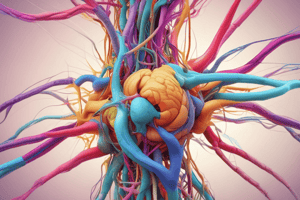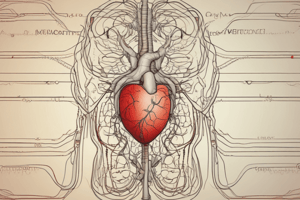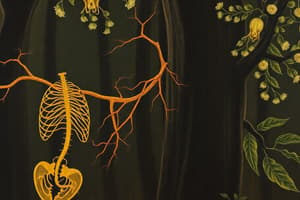Podcast
Questions and Answers
Which division of the nervous system is responsible for voluntary control of skeletal muscles?
Which division of the nervous system is responsible for voluntary control of skeletal muscles?
- Autonomic nervous system
- Somatic motor system (correct)
- Parasympathetic nervous system
- Sympathetic nervous system
Which of the following is a component of the central nervous system?
Which of the following is a component of the central nervous system?
- Parasympathetic nervous system
- Somatic motor system
- Autonomic nervous system
- Brain (correct)
Which part of the autonomic nervous system is often referred to as the 'rest and digest' system?
Which part of the autonomic nervous system is often referred to as the 'rest and digest' system?
- Central nervous system
- Sympathetic nervous system
- Somatic motor system
- Parasympathetic nervous system (correct)
The peripheral nervous system includes:
The peripheral nervous system includes:
During a stressful situation, which part of the autonomic nervous system is likely to become more active?
During a stressful situation, which part of the autonomic nervous system is likely to become more active?
Flashcards
Central Nervous System (CNS)
Central Nervous System (CNS)
The control center, including the brain and spinal cord.
Peripheral Nervous System (PNS)
Peripheral Nervous System (PNS)
The network of nerves branching out from the CNS, connecting it to the rest of the body.
Somatic Motor System
Somatic Motor System
Controls voluntary movements through skeletal muscle.
Autonomic Nervous System (ANS)
Autonomic Nervous System (ANS)
Signup and view all the flashcards
Sympathetic Nervous System
Sympathetic Nervous System
Signup and view all the flashcards
Study Notes
-
Central Nervous System (CNS)
- Comprises the brain and spinal cord
-
Peripheral Nervous System (PNS)
- Includes all neural tissue outside the brain and spinal cord
Somatic Motor System
- Governs voluntary movements of skeletal muscles
Autonomic Nervous System (ANS)
-
Regulates involuntary functions
-
Two primary divisions:
- Parasympathetic nervous system
- Sympathetic nervous system
Parasympathetic Nervous System
- Often referred to as the "rest and digest" system
- Promotes relaxation, digestion, and energy conservation
- Key functions:
- Slows heart rate
- Increases intestinal and gland activity
- Relaxes sphincter muscles in the gastrointestinal tract
Sympathetic Nervous System
- Often referred to as the "fight or flight" system
- Prepares the body for stress, emergencies, and physical activity
- Key functions:
- Accelerates heart rate
- Dilates pupils
- Increases blood flow to muscles
- Inhibits digestion
- Stimulates the release of glucose
Somatic Motor System (In Detail)
- Controls voluntary muscle movements
- Involves one motor neuron extending from the spinal cord to the skeletal muscle
- Neurotransmitter released at the neuromuscular junction is acetylcholine (ACh)
- Stimulation of the somatic motor neuron always leads to muscle contraction
- No ganglia outside of the Central Nervous System involved
Differences between Somatic Motor and Autonomic Nervous System
-
Somatic motor system involves a single motor neuron from the CNS to the skeletal muscle, while the autonomic nervous system uses a two-neuron chain (preganglionic and postganglionic) to reach the target organ
-
Somatic motor system controls skeletal muscles, while the autonomic nervous system controls smooth muscles, cardiac muscles, and glands
-
Somatic motor system is primarily voluntary, while the autonomic nervous system is involuntary
-
Somatic motor neurons release acetylcholine (ACh), while autonomic neurons release acetylcholine (ACh) or norepinephrine (NE)
Autonomic Nervous System (In Detail)
-
The ANS is responsible for maintaining internal body homeostasis
-
Preganglionic neurons originate in the CNS, while postganglionic neurons extend to target organs
-
Ganglia are clusters of neuronal cell bodies outside the CNS, where preganglionic neurons synapse with postganglionic neurons
-
The parasympathetic division has long preganglionic fibers and short postganglionic fibers, with ganglia located near or within the target organs
-
The sympathetic division has short preganglionic fibers and long postganglionic fibers, with ganglia located closer to the spinal cord
-
The parasympathetic preganglionic and postganglionic neurons release acetylcholine (ACh) as their neurotransmitter
-
The sympathetic preganglionic neurons release acetylcholine (ACh), while most postganglionic neurons release norepinephrine (NE)
-
The autonomic nervous system regulates various bodily functions including: -Heart rate -Blood pressure -Digestion -Respiration -Sweating -Pupil dilation
Integration of Sympathetic and Parasympathetic Functions
-
Most organs are innervated by both sympathetic and parasympathetic fibers, allowing for precise control
-
These two divisions often have opposite effects on the same organ, creating a balance that maintains homeostasis
-
Examples of dual innervation include:
- Heart rate: Sympathetic increases, parasympathetic decreases
- Digestion: Sympathetic inhibits, parasympathetic stimulates
- Pupil size: Sympathetic dilates, parasympathetic constricts
-
In some cases, only one division innervates an organ (e.g., sweat glands, adrenal medulla), in which case regulation is achieved by increasing or decreasing the activity of that division
Neurotransmitters in the Autonomic Nervous System
-
Acetylcholine (ACh)
- Released by all preganglionic neurons in both sympathetic and parasympathetic divisions
- Released by postganglionic neurons in the parasympathetic division
- Binds to cholinergic receptors (nicotinic and muscarinic)
-
Norepinephrine (NE)
- Released by most postganglionic neurons in the sympathetic division
- Binds to adrenergic receptors (alpha and beta)
Cholinergic Receptors
-
Nicotinic receptors
- Located on postganglionic neurons in autonomic ganglia and on skeletal muscle cells
- Activated by acetylcholine (ACh)
- Ligand-gated ion channels
-
Muscarinic receptors
- Located on target organs of the parasympathetic nervous system
- Activated by acetylcholine (ACh)
- G protein-coupled receptors (GPCRs) with diverse effects
Adrenergic Receptors
-
Alpha (α) receptors
- Subtypes include α1 and α2
- Generally excitatory effects (e.g., vasoconstriction)
- Located on various target tissues of the sympathetic nervous system including smooth muscle
-
Beta (β) receptors
- Subtypes include β1, β2, and β3
- Generally inhibitory effects (e.g., vasodilation, bronchodilation) but excitatory on the heart (increased heart rate and contractility)
- Located on various target tissues of the sympathetic nervous system including the heart, lungs and smooth muscle
Control Centers in the CNS
- Autonomic functions are regulated and coordinated by several brain regions
- Hypothalamus
- Major integration center for autonomic functions
- Influences heart rate, body temperature, water balance, and endocrine activity
- Brainstem (medulla oblongata and pons)
- Regulates heart rate, blood pressure, and respiration
- Cerebral cortex and limbic system
- Can influence autonomic functions via emotional responses and conscious control
Clinical Significance
- Many diseases and conditions can affect the autonomic nervous system, leading to dysfunction and various symptoms
- Examples include:
- Hypertension (high blood pressure)
- Postural hypotension (low blood pressure upon standing)
- Arrhythmias (irregular heartbeats)
- Irritable bowel syndrome (IBS)
- Raynaud's phenomenon (reduced blood flow to extremities)
Aging and the Nervous System
-
Natural aging affects both the central and peripheral nervous systems
-
Effects include:
- Decline in cognitive function
- Reduced blood flow to the brain
- Slower reflexes
- Loss of neurons
- Impaired motor coordination
- Sensory deficits
-
The brain also shrinks in size as people age and the ventricles may expand. This is due to the loss of neurons and synapses.
-
In the peripheral nervous system, there may be a decrease in nerve conduction velocity, which is the speed at which electrical signals travel along nerves
Studying That Suits You
Use AI to generate personalized quizzes and flashcards to suit your learning preferences.
Description
Overview of the nervous system, including the central (brain and spinal cord) and peripheral divisions. Covers the somatic motor system for voluntary movements and the autonomic nervous system regulating involuntary functions. Explores the parasympathetic (rest and digest) and sympathetic (fight or flight) systems.




